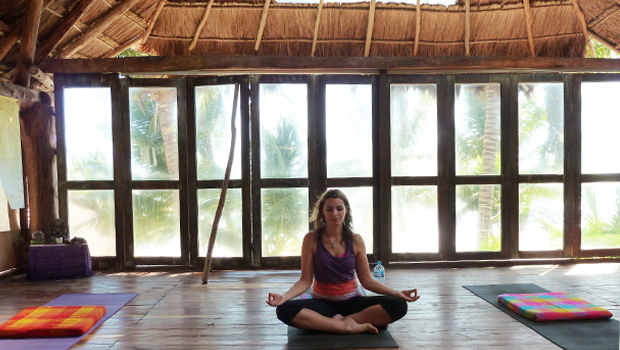How to create your own DIY yoga retreat
I previously wrote about the benefits of attending a yoga retreat overseas, such as deepening your practice, gaining more clarity in life and learning healthy habits. What if you have the opportunity to take time out for a yoga holiday and there are no retreats that match your dates or you don’t have the right funds at the time? This is when a DIY yoga retreat can come to the rescue. Having done a combination of yoga retreats, training and yoga trips overseas myself, I know first hand that each option provides a lot of growth, relaxation and strengthening of your practice.
Recently I had a few weeks available to me and needed to de-stress from the pressures of life. I really wanted to go somewhere warm with a beach and create my own space to meditate, practice yoga, run on the beach, read my book (Autobiography of a yogi) and source fresh plant based food I could prepare myself.
Here are some ways that worked for me that you can use to create your own peaceful, uplifting and healthy yoga retreat.
1. Set your intention
Do you already have an established practice and want a more solo and reflective retreat? Are you looking to attract like-minded people and share your retreat with others? Perhaps you want a mix of both? Establishing what type of retreat you want is the first step towards creating your rejuvenating trip. In my recent case I wanted to practice yoga with others so chose Sayulita, Mexico by the beach where there were a few yoga studios and picked one I could go to on a daily basis and connect with like minded people.
2. Plan your itinerary
Deciding whether you want more of a planned itinerary such as meditation at 7am and yoga at 10am and 3pm versus playing it by ear is also important to establish. Will your retreat mostly be about a yoga class a day followed by relaxing beach time and reading? Do you want to throw in a few adventurous activities? During my DIY yoga retreat in Sayulita, Mexico I woke up at 7am every morning to meditate then went running every second day before my yoga class at 9.30am. After class, I made my smoothie and lunch and read by the beach. As I wanted to mix fitness with my yoga retreat and honor my daily meditation practice, I found having a set routine worked best for me.
3. Find the right location
Now that you know what type of retreat you want to create, the next step is to find an environment that supports your intentions. If you want a solo retreat, then a beautiful and quiet place in nature may suit your needs such as a warm turquoise beach in Thailand or a rolling mountain town in Sardinia. For a more shared and inspired retreat from other teachers and yogis, then locating a destination with good yoga studios is key. When I wanted to create a yoga retreat for myself in Mexico, I researched where the most yoga was and decided to go to both Tulum and Sayulita. I was able to take classes and become friends with yoga teachers at the studio’s there, as well as meet other traveling yogis. The best way to locate a yoga-centric location in your chosen country is to use Google, ask other yogi friends and take note of common retreat locations. Usually there are a number of yoga studios in areas where many retreat are held.
4. Find a supportive environment
Finding the right environment is also key. If you want a week of peace, quiet, good food, nice weather and relaxation you want to find somewhere that supports this goal. Ending up in a loud party place full of unhealthy food, pollution and noise is not going to support your intentions eg Haad Rin, Thailand during the full moon party. When I searched for locations that had yoga studios I also made sure these locations were quiet and a little bit more isolated (like Sayulita, Mexico and Haad Tien, Thailand) which means it’s harder for general tourists to get to.
A place that has more yoga also increases the chances of having more yoga related activities (meditation, workshops), food (vegetarian, organic) and things (clothes, mats) available.
5. You are what you eat
Eating on the lighter and plant based side is known to support health, mental clarity and positive thoughts. Eating nourishing food during your retreat is key to achieving a full body, mind and soul balance. Make sure there is healthy and light food available near your retreat. Look for juice or smoothie huts, organic food and farmers markets. Preparing your own food is a safe and often cheaper way of eating, as you know exactly what you are getting. While in Sayulita, I stayed in a bungalow on the beach with a little kitchenette. I had access to a blender to make my green smoothies in the morning and I bought iodine solution to wash my fruit and vegetables before making salads. I was pleasantly surprised to discover a weekly farmers market there full of organic food and superfoods (score!). I also always travel with raw vegan protein power, greens powder and a combination of organic tea and superfoods (hemp seeds, chia seeds etc) to supplement my local diet when traveling.
6. Journal and reflect
Yoga retreats whether organized or DIY are a good way to process information, reflect and set future goals and intentions. Bringing a journal to note down these transformations is key, as is reading books that support your growth. I often like to start with a brand new journal to create a new start for my intentions. A good copy of the Bhagavad Gita or Patanjali Yoga Sutras are good books to compliment your retreat and expand your Vedic knowledge.








